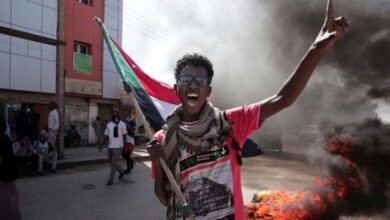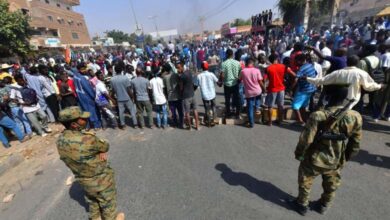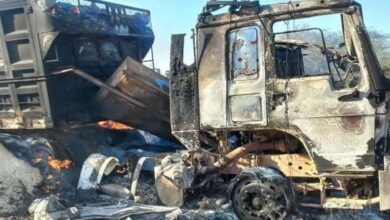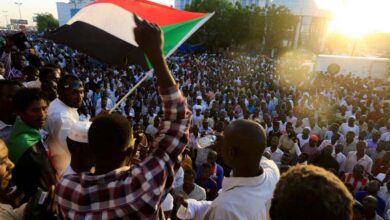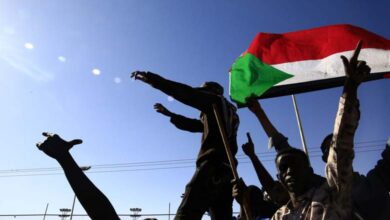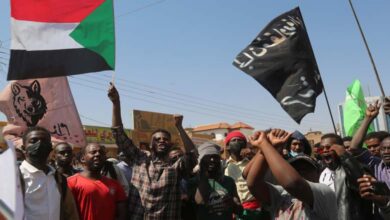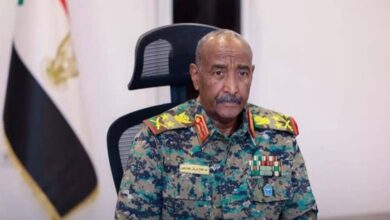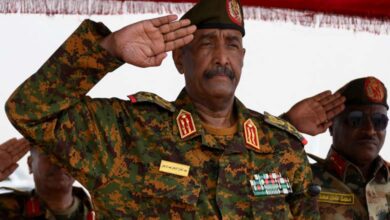The Sudanese Army: A History of Islamist Dominance
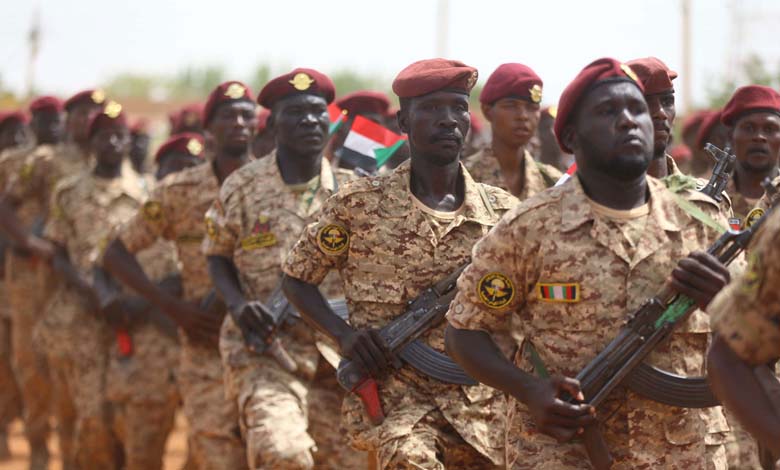
The core issue in the Sudanese crisis lies in the manner of rebuilding the army, which was subjected to ideological politicization and the whims of three military regimes described as “dictatorial and coup-prone”, swinging from the far left to the extreme right. This led the army into the grip of the Muslim Brotherhood group “The Islamic National Front”, especially with its infiltration into its formation and its control of governance. Consequently, Omar al-Bashir‘s coup in 1989, which lasted until 2019, resulted in the purge and dismissal or execution of nationalist elements within it.
In his book “The Sudanese Army and Politics,” military affairs researcher Colonel Essam al-Din Mergani (one of the founders of the military political opposition to the Islamic National Front regime) sheds light on a century-long period, starting from the establishment of the “Sudan Defense Force” in 1925, then the declaration of the “Sudanese Army” in January 1954, and finally the “Sudan Armed Forces” until today.
Mergani observes that throughout most of this period, the Sudanese army was at the forefront of the political events that shaped modern Sudanese history, noting that the book’s aim is to research the historical roots of the Sudanese army‘s entry into politics, and to track the factors and influences that led to its successive interventions, overthrowing civilian democratic authority, thereby making Sudan one of the most militarily dominated and ruled countries in Africa under dictatorial military regimes.
The book, which comes in two parts, covers the roots and expansion of political work within the Sudanese armed forces, attempting to document most of the military-political events that have left their mark on Sudan. In the second part, it focuses on the experience of political-military opposition to comprehensive military regimes in Sudan.
Mergani delves into the infiltration of the Muslim Brotherhood (Islamic National Front) into the Sudanese army since 1949, dedicating much of his chapters to their penetration strategy of the army and the construction of an Islamic military, and their seizure of everything to secure their power. He lists the leaderships that followed the organization from its inception until taking power in 1989 under the leadership of Omar Hassan Ahmed al-Bashir and its subsequent Islamization of the Sudanese Armed Forces, purging and dismissing non-aligned elements, its crackdown on the March 1990 movement, and its commitment to the 1990 massacre by executing many officers described as the blessing of its ruling elements represented by al-Bashir and the new army leadership.
Mergani traces the birth of the Muslim Brotherhood movement in Sudan when the Brotherhood officer Abul Makarim Abdel-Hai sought refuge in Sudan from the July 1952 revolution in Egypt and the pursuit of movement elements. Abul Makarim was responsible for the organization’s special apparatus in Egypt, responsible for clandestine work within the army and police, thus transferring secrets and the entire experience to Sudan to establish the organizational structure in dealing with the Sudanese Muslim Brotherhood in the army and in the style of clandestine work and planning to seize power in subsequent epochs.
He notes that the first serious attempt by the Brotherhood to enter power through the Sudanese army was in 1959 when Rashid al-Tahir Bakr, the general supervisor of the Muslim Brotherhood at the time, established close ties with some officers working in the eastern command in Al-Qadarif and opened a project with them to overthrow the rule of General Ibrahim Abboud and seize power. This attempt was known as the November 9th coup in 1959, or the coup of Major Ali Hamed, which was aborted before implementation, and afterwards five officers were sentenced to death, and Rashid al-Tahir Bakr was sent to prison for five years.
The Muslim Brotherhood distanced itself from responsibility for the November 9th, 1959 coup, although it held a funeral prayer for the souls of the executed officers and demonstrated during their burial.
Mergani confirms that the Sudanese Muslim Brotherhood spared no effort in building its organizational foundations since the 1950s amidst the student movement in elementary and secondary schools, to strengthen this expansion and consolidate it at the University of Khartoum later on.
Throughout the sixties and seventies, the Sudanese army mainly relied on recruiting military students after completing their secondary education, with recruitment to the military college decreasing from lower educational stages or officer ranks. Many officers with Brotherhood inclinations had been recruited since their student days, unnoticed by the army leadership at the beginning of their service, and this became evident when they appeared as retired workers who had been reassimilated into Islamic Front organizations after 1985.
He believes that the Muslim Brotherhood absorbed the failure of its attempted coup against the May regime (1969-1977) and the failure of the armed external opposition experience, and the necessity of reconciling with the regime before all other components of the “National Front.” They were the first to send a memorandum from inside Kober Prison in 1977, calling for reconciliation and engagement with the May regime.
This was achieved on July 7, 1977, when Sadiq al-Mahdi, the head of the opposition National Front, signed the National Reconciliation Agreement in Port Sudan. After the reconciliation, all their efforts focused on organizational work, marking the true beginning of serious secret organizational work in the student movement, their only asset until then, and their secret activities extended to all other sectors, including the armed forces and security agencies.
The late Brotherhood leader Hassan al-Turabi says, “After the reconciliation in 1977, there was a comprehensive organizational renaissance based on the experiences of the jihad period, and assimilating its harvest in the extensions of social, economic, security, and external work, and it continued for years, bringing about a transformation.”
The Brotherhood‘s organizational launch and expansion were aided by the large financial capabilities available to it during the external work period and the profitable commercial investments made by the organization’s cadres, especially in Saudi Arabia and the Gulf region.
Mergani points out that al-Turabi formulated his strategy for building the organization on four dynamic pillars: expansion, penetration, occupation, and seizure. The movement operated in four main axes: the economic field, the student movement, media and publishing, and the armed forces and other security forces.
“All sources agree that the serious start of building an effective military organization for the Muslim Brotherhood within the armed forces occurred after 1980. The first military official of the organization to be appointed after that date was Air Force Commander Mokhtar Mohammedien, who was killed as a colonel when his plane crashed in the city of Al Nasir on the Upper Nile at the end of 1988. Sources also concur that the recruitment of Colonel Pilot Mohammedien was facilitated by Rashid Abdelrahim, a Brotherhood cadre working in journalism, who had a direct kinship to Mohammedien.
Commander Mohammedien initiated a clandestine recruitment campaign within the air force, and Commander Pilot Mustafa al-Duweihy informed me that he was on an official mission to Germany in the early 1980s accompanied by Mohammedien, who vigorously attempted to recruit him for the Muslim Brotherhood, but he declined, clinging to his nationalism and allegiance to the armed forces. Colonel Aeronautical Engineer Abdelrahim Mohammed Hussein was Mohammedien’s right-hand man in the organization, and together they managed to build a strong base for the Brotherhood within the air force, as evidenced by the significant number of participants among the technical officers of the air force during the June 30, 1989 coup.”
He reveals that the second man in the organization, who made significant efforts in building the secret military organization and was entrusted with vital tasks before the coup, was Colonel Kamal Ali Mohatar, a committed cadre in the Brotherhood since his high school years at Dongola Secondary School, but he concealed that information by demonstrating absolute nationalism toward the armed forces and applying the utmost secrecy and caution in his organizational movements and activities. In the late 1970s, Mohatar was dispatched to the Gulf region to work as an expert in the United Arab Emirates Army. This period was the golden age of the Brotherhood‘s work in the Gulf and Saudi Arabia, and it was intelligently utilized to develop secret organizational work and enhance economic capabilities. During his tenure in the Emirates, Mohatar recruited numerous cadres for the organization, and he was directly assisted by Commander Omar Hassan al-Bashir, who was also seconded to the UAE army at that time.
Mergani emphasizes that Omar Hassan al-Bashir, the leader of the National Islamic Front coup and president of the National Salvation Government in 1989, after the dispute and division within the Islamic Front ranks in December 1999 between Hassan al-Turabi and the group led by Ali Osman Mohamed Taha (who had a relationship with al-Bashir since their time together at Khartoum Secondary School, and who was on the Brotherhood‘s list in the school’s student elections and won its presidency).
Al-Bashir revealed at a press conference held at the headquarters of the National Congress Party – the ruling party of the Islamic Front – on the evening of December 14, 1999, the truth about his affiliation, which he had denied for ten years while he was at the helm of the Salvation Government regime from June 1989 to December 1999.
Mergani writes in his book: “The acknowledgment by General Omar al-Bashir, President of the Republic of Sudan, clearly showed that he was involved in the Islamic movement since his first year of high school. He stated that the seizure of power on June 30, 1989, was ordered by the leadership of the Islamic Front.”
He explains that in 1983, the Brotherhood succeeded in creating all favorable conditions for the construction and spread of the political and military organization of the movement, as Brotherhood leadership reached decision-making positions in ministries and sovereign bodies of the May regime. This allowed them to know all state secrets, obtain the most precise details, and become proficient in governance.
The movement managed to contain the failing May regime in its policies and escalating internal and external opposition, pushing it to seek refuge behind repressive laws steeped in Islam crafted by Brotherhood cadres and ironically named Islamic Sharia laws… Religious trafficking fever escalated, with President Gaafar Nimeiry leading its charge, whom the Brotherhood recognized as the “Imam of Muslims.” The civil service and civil society institutions were most affected by these new policies, liberal and secular leaders were sidelined, and Sudan entered the final stages of the era of decay and a return to the Middle Ages, a transition that would continue in the 1990s.
He estimates that the Sudanese armed forces bore the brunt of it, with most of their fate being in the hands of the Brotherhood, as senior military leadership was purged, officers publicly humiliated, and the gates of military units opened to Brotherhood preachers and missionaries, as well as those who shared their religious fanaticism, to give lectures and conduct religious courses under the guise of preaching and religious guidance and moralization… It was astonishing to see a large number of soldiers from the armed forces, belonging to Christian denominations and spirit worshippers from southern Sudan and the Nuba Mountains region, forced to attend the lectures… As for the leaders of the armed forces who embraced the enlightened directives laid down by “Imam Nimeiry,” they were in a state of lethargy.
Mergani reveals that the Brotherhood‘s greatest achievements came from its branch and dedicated institution, known as the “African Islamic Center.” This center was chosen to become the branch for moral guidance within the armed forces, and it rode the religious wave by planning the necessary courses in religious guidance, pushing the officers’ affairs branch to regularly send officers to attend courses offered by the center. The argument put forward by the moral guidance branch was that the armed forces could benefit from the training of these officers in spreading awareness and religious commitment in line with the Islamic orientation of the state… These courses began in 1983 and continued until the Islamic Front coup on June 30, 1989, and it is likely that they continue until today. The courses of the African Islamic Center were an open cell for recruiting officers from the armed forces into the ranks of the Brotherhood, or at least for gaining their sympathy and support for its policies.


